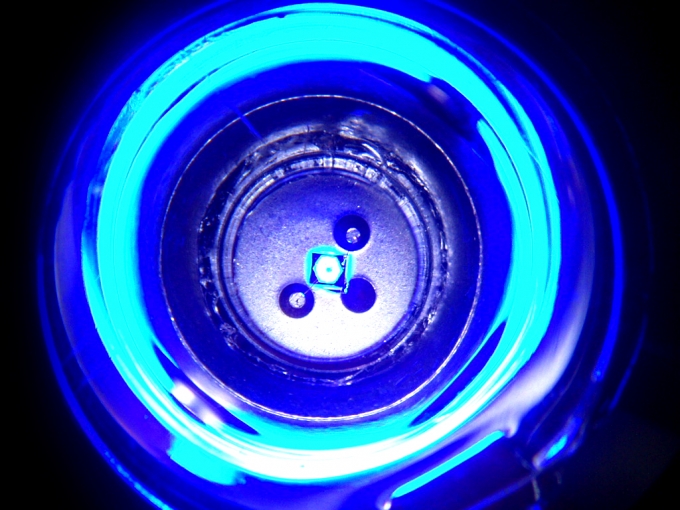In the early 1990s, few people were thinking about semiconductors as a lighting source. Red LEDs were being used as traffic lights and as power-indicator lights on electronic equipment, but lacking blue and green, the path to pervasive LED lighting was hard to see. Infrared was the source of long-wavelength communications used for the internet and for telephone connections, so, accordingly, early semiconductor work was communication-driven.
Then, in 1993, after more than a decade of work, Shuji Nakamura, at the time a researcher for Nichia Chemical in Japan, and two colleagues at Nagoya University, used gallium nitride (GaN), a complex, problematic semiconductor that was out of favor with most LED researchers, to develop the first blue LED.
The blue LED made e white LED possible, which appeared two years later and has since revolutionized the lighting industry and earned a Nobel Prize for Nakamura and his Nagoya colleagues.
Since coming to UCSB in 2000, Nakamura has worked closely with his SSLEEC colleagues to develop brighter and more efficient LEDs. His first GaN LEDs were very bright but only 2-percent efficient. Now, blue LEDS are 84-percent efficient, red LEDs are at about 60 percent, and green are at 30 percent, while the incandescent bulb they are rapidly replacing is still only about 3-percent efficient. Those gains, says DenBaars, are a result of “too many things to list. It’s just steady progress in materials science.”
Claude Weisbuch was hired as a part-time faculty member through a special Regents Professors program in 2002. He has made important contributions in the area of LED light extraction, addressing the fact that when a GaN semiconductor generates light, that light tends to remain inside the semiconductor, so the LED has to be treated to release it. James Speck describes Weisbuch as “the world expert” on semiconductor light extraction.
Weisbuch pioneered a technique that employed photonic crystals, and Nakamura developed a now-widely used technique called “roughening” of the LED. Both processes greatly increased light-extraction efficiency in LEDs.
A comparison to the important advances in the efficiency of photovoltaics helps to put the dramatic gains in LED efficiency into perspective. During the past two decades, solar cells improved from 30-percent efficiency to just over 40-percent. During the same period, LEDs improved from 2-percent efficiency to a maximum of 84 percent for the most efficient blue LED. A white 50-percent-efficient LED for home use was introduced at Costco in 2014.
“Efficiency resulted from the reduction of the defects in GaN through better crystal structures,” said Speck, who worked closely with Nakamura and SSLEEC co-director Steve DenBaars to develop growing methods that resulted in better crystals that had fewer defects and therefore conducted electricity with greater efficiency. Efficiency also resulted from the GaN-on-GaN semiconductor structure, which was developed at the center.
In 2007, two new technologies gave LED lighting a hugely expanded presence in the consumer world. Together, the first iPhone — which had a color display screen lit by LEDs that were built on GaN-based semiconductor technology developed at UCSB — and the widespread adoption of LED televisions drove tremendous new volume and demand, accelerated LEDs into lighting, and resulted in multi-billion-dollar markets that would drive down the cost of the lights. The same LED light bulb that cost $300 in 2007 costs just $3 today.
Tremendous energy savings have resulted. A 2015 Forbes article estimated that by 2030, LED light bulbs would save enough energy in the U.S. alone to eliminate the need for fifty power plants.
“We built our center on solid-state lighting,” DenBaars said in 2017. That decision and the commitment to pushing the limits of GaN as a semiconductor have proved immensely valuable, in terms of both driving new technology and doing so with immense savings in energy use.
LEDs are now everywhere, and new markets continue to arise. More than a million people die from water-borne illness ever year, but if they had access to something like the Steri-pen, which employs UV LEDs to purify water quickly and is popular with backpackers and others who drink from questionable water sources, that number could drop dramatically.
The LED story is more interesting — and more important — every day.

A blue LED glows at the center ofa cone encapsulant.
